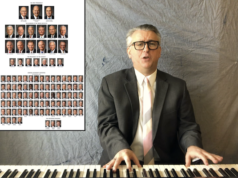It is a bold endeavor for a first-time filmmaker to take a beloved story like Jane Austen’s “Pride and Prejudice” and set it in the 21st century, but Andrew Black has done it and has done OK with it.
Then again, the transition from 19th-century marriage-minded women to modern-day Brigham Young University co-eds wasn’t really such a leap. And that, I suppose, is at least one of the jokes inherent to this cute, well-produced film that suffers only in its slow pace and unfortunate editing.
Our heroine is Elizabeth Bennet (Kam Heskin), a 26-year-old BYU student with an independent mind and only a casual interest in getting married. She’s some sort of freak, in other words, and the guys can’t figure her out. One fellow, Jack Wickham (Henry Maguire), has proposed a number of times, but she dismisses him and remains his friend, causing what appears to be an easy-going level of frustration for him.
Her roommates are a mixed bunch. Sisters Lydia and Kate (the very amusing duo of Kelly Stables and Nicole Hamilton) calibrate their every move to maximize man-catching potential, Mary (Rainy Kerwin) is a hopeless nerd, and perhaps even insane, and Jane (Lucila Solá), from Argentina, has just landed the wealthy, cute and earnest Charles Bingley (Ben Gourley).
Charles’ English friend Darcy (Orlando Seale), visiting from his current home in California, has a run-in with Elizabeth but soon finds himself smitten with her intelligence, a trait he finds lacking in many of her contemporaries. Elizabeth is indifferent, and Charles’ sister Caroline (Kara Holden), a cold, devious golddigger, wants Darcy for herself.
And thus the romantic comedy machine is set in motion, with characters bound to fall in love, fall apart and fall back together again. Director Andrew Black, whose short film “The Snell Show” took top prizes at Slamdance this year, displays more talent than many new directors do, particularly at corralling so many characters into a single coherent story. The script, by Anne K. Black, Jason Faller and Katherine Swigert, is suitably light-hearted, and has a few good one-liners to its credit.
The film’s trouble is in its editing, also done by a rookie, Alexander Vance. There’s a very slow energy to the film, and it’s because of how the shots are assembled. There are often small pauses between one character’s line of dialogue and the other character’s response. Conversations come across as protracted, and it’s definitely the editing: When two characters speak to each other within the same shot, without cutting from one to the other, the pauses aren’t there and the pace seems normal.
There’s also the matter of the montage scenes, of which there are far, far too many. When the film is nearly over, literally four or five lines of dialogue to go, what do we get? A montage of England to establish that the concluding scene will take place there. Wholly unnecessary, and even more aggravating given how many useless montages have already been shown. (The driving-to-Vegas one springs readily to mind.)
I can’t overstate the problem. With tighter editing, this would be a B or B+ film, easily. The energy would be higher and the jokes would seem funnier. So many scenes wouldn’t feel like cold, stilted readings, they way they do now.
It’s a shame, because some of the performances are delightful indeed. Kam Heskin is a worthy heroine as Elizabeth and she carries the movie well. Her post-breakup ice cream binge-eating sequence with Lucila Solá’s Jane is especially funny. I also liked Hubbel Palmer as Collins, a fantastically dorky newly returned missionary whose advances are not welcomed by anyone. Remember the similar character, DeVerl, in “The Singles Ward”? Palmer actually gets it right here, succeeding at being both funny and believable.
“American Idol” castaway Carmen Rasmusen has a cameo, but it’s so dumb I’m going to pretend it didn’t happen.
If you’re interested, though “Pride & Prejudice” taglines itself “a latter-day comedy,” its connection with The Church of Jesus Christ of Latter-day Saints barely goes any further than that. There’s a scene set in a Mormon sacrament meeting, and it’s assumed all of the characters are LDS; one of them is seen reading the Book of Mormon in one of the aforementioned numerous montages. References to doctrine are almost non-existent. In other words, the film is accessible to one and all, with no footnotes or explanations necessary. And if it were a little better assembled, it would be enjoyable to one and all, too.
C+ (1 hr., 43 min.; )





